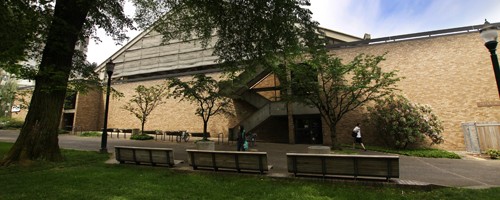It really is rocket science
When computer science professor Bart Massey came to Portland State, he saw a sign that read, "Do you want to build rockets?"
"I thought to myself that either those guys were real dorks or they were doing something really cool," Massey said.
The group was the Portland State Aerospace Society (PSAS), and apparently what they were doing was cool, because Massey is now the faculty advisor. PSAS has a simple vision statement: they plan to put nano-satellites into orbit using rockets.
Not your typical student activity group. Not your typical rockets, either.
They are currently working to devise an inexpensive, modular and actively guided suborbital sounding rocket, an important first step to achieving orbital spaceflight. The group’s current rocket, LV2, is 11 feet tall and is tentatively scheduled for an April 2005 launch. In a burn time of 5-10 seconds it will reach Mach 2.4 and an altitude of 25,000 feet.
Although several groups around the world are also working in the field of amateur rocketry, Massey characterizes most of those efforts as being "big bottle rockets: a tube, some really big engines and a fuse. You light the fuse and the rocket goes up. But no one knows where it’s going to come down."
The PSAS rockets are different. Their computer takes them up, and their computer brings them back down.
"Our use of avionics and navigation is unique. In the world of amateur rocketry, we’re really the only ones doing this stuff," Massey said.
When asked how his involvement with PSAS began, Massey has background in programming, artificial intelligence and engineering, "all that stuff that predisposes you to get into trouble," he said.
Massey waxes on about the upcoming launch of LV2, and the chance to try out the new navigation system. "It’s simple: to fly an active guided rocket, you need good active guidance," Massey said.
The IBM Corporation has awarded Massey a 2005 Innovation Grant worth $21,000. The award recognizes his groundbreaking research in on-board rocket control systems.
Massey is one of 11 researchers worldwide to receive an Innovation Grant. Five of 11 recipients are from the U.S. The other six hail from Russia, Italy, Spain, India and China.
The IBM grant will allow PSAS to purchase three IBM Power PC processors, creating a better, faster flight computer for the group’s latest rocket, the LV2.
Massey believes that the "souped-up" computer will do a better job at handling in-flight navigation tasks.
"The current rocket has a stock LINUX central flight computer. It’s an Advanced Microsystems Device, and it’s worked pretty well. It’s low power and easy to program," explained Massey. "But it’s maxed out – it can’t do what we need it to do anymore. The IBM Power PC processors will allow us to do a lot more."
Although PSAS is an official PSU student organization, it receives no student incidental fee money, and most PSAS activities are funded out of members’ pockets. Massey is grateful for the recent grant award, and sees it as critical to the progress on LV2.
"It’s important to me to emphasize the role of IBM," Massey said. "They’ve established a LINUX technological center in Portland – it’s one of only two in the U.S. So the chance to work on our grant in such close association with them is terrific. They’re to be commended for giving us this money."
Massey had received other grant awards for his work with rockets. In 2002, a $10,000 grant from the NASA Oregon Space Consortium supported the development and testing of the LV2 craft. And a 2005, $68,000 NASA Small Business Initiative Research (SBIR) grant will allow Massey and his team to create and test artificial intelligence-based vehicle health maintenance software.
"Tim Menzies is really in charge of the AI work. It’s a simulator-based machine-learning software. We’re trying to teach machines to do vehicle repair in real-time, in-flight," Massey said.
"We’re in Phase I right now. We’re running simulated mission failures and teaching the AI to conduct repairs on its own," explained Massey.
In Phase II of the SBIR project, NASA will use the PSAS AI software in its own rockets.
He says that one of the reasons that IBM was so interested in PSU’s program was because of the learning opportunities for the students.
"There’s one kid, Jamey Sharp, who heads our software team. When he was 15 he started taking classes at PCC. Then he heard about PSAS, and joined up," said Massey.
"Now Jamey’s 19 or 20 and he’s graduating from PSU this spring with a degree in Computer Science. He’s already co-published five papers. The sky’s the limit for this kid – he’ll be able to do whatever he wants. And I’m thinking that if PSAS hadn’t been here, and given him the opportunities it did, he might not be where he is today."
While PSAS is primarily a student group, it also has community members.
"We’re always looking for new members, for anyone who’s intelligent and has some free time," Massey said. "We don’t just need computer and engineering people – we’re looking for all sorts of contributors. We need everything from welding to trip planning to document preparation."




